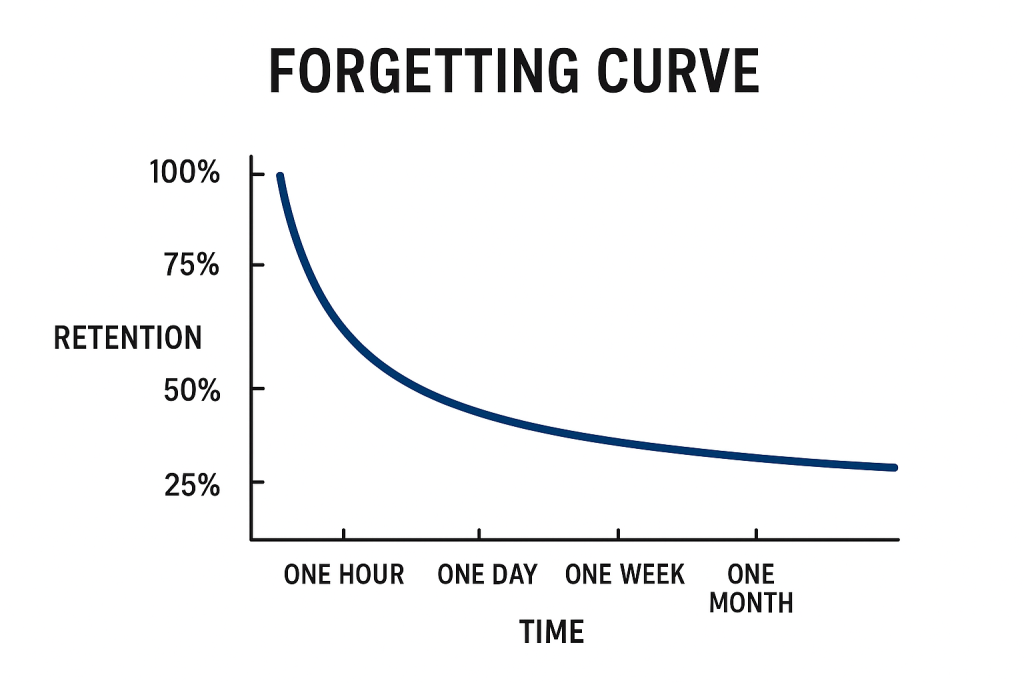In today’s competitive corporate world, simply delivering training isn’t enough. Employees don’t just need information; they need transformation. This is where neuroscience based training steps in — a powerful approach that blends brain science with learning strategies to unlock true potential.
Think about the last time you struggled to remember a new process at work. That’s because the human brain isn’t designed to absorb bulk information at once. Neuroscience based training leverages concepts like spaced repetition, neuroplasticity, and dopamine triggers to make learning stick naturally. When employees experience micro-moments of success, their brains release dopamine, creating stronger memory pathways.
You know that feeling when you walk into a training room and see blank faces, learners scrolling through their phones, or worse — fighting to stay awake? We’ve all been there.
Now picture a different scene: the same topic, the same trainer, but this time, learners are leaning forward, asking questions, and staying back after the session to discuss ideas.
What changed?
It wasn’t the trainer. It wasn’t the topic.
The difference was the brain.
Welcome to the Ultimate Guide to Neuroscience Based Training — your step-by-step playbook for designing learning experiences that stick, motivate, and transform. In this guide, we’ll break down the science of learning into practical strategies you can implement immediately — no PhD required.

Why Your Training Needs Brain-Based Learning Techniques
Here’s the hard truth: most training programs fail, not because the content is bad, but because they fight against how the brain learns.
Traditional, lecture-heavy sessions dump information on learners, expecting them to magically retain and apply it. But the human brain has limits. When overloaded, it shuts down processing and slides into forgetting mode.
Research shows that after a typical training session:
- Learners forget 50% of new information within an hour
- 70% is gone within 24 hours
- 90% vanishes after a week

That’s why neuroscience based training matters: it works with the brain, not against it.
3 Signs Your Training Is Fighting the Brain
- Information Avalanche: You try to cover too much at once, causing cognitive overload.
- Minimal Retention: Learners ace the end-of-session quiz but can’t apply concepts weeks later.
- Silent Rooms: Participation is low, and learners feel more like spectators than contributors.
How to Implement This Monday:
Audit your next training. If you’re speaking for more than 20 minutes without interaction, pause and add a learner activity — even a quick poll or discussion. Brains learn in bursts, not marathons.
The Trainer’s Cheat Sheet to the Learning Brain
To design neuroscience based training, you need to understand how the brain receives, processes, and retains information. Let’s decode four key principles — with trainer-friendly analogies you’ll actually use.
1. Neuroplasticity: The Brain’s Gym Workout
Think of the brain as a muscle. Every time learners practice a skill, they build and strengthen neural pathways. Without repetition, those pathways fade.
But here’s the catch: repetition alone isn’t enough. For maximum retention, learners need variety and challenge — the brain thrives when it’s pushed just enough to stay engaged.
Trainer’s Tip: Replace “read-and-recall” exercises with practice-based learning:
- Role-play tricky scenarios
- Use simulations to apply concepts
- Introduce “what-if” problem-solving challenges
The more multisensory the activity, the stronger the neural connections.
2. Amygdala & Stress: Fear Blocks Learning
The amygdala — your brain’s threat detector — decides if learners should fight, flee, or focus. When learners feel anxious, judged, or unsafe, the amygdala triggers stress responses that literally shut down higher-order thinking.
Story: During a leadership workshop, I replaced the dreaded “opening test” with a fun puzzle. Within minutes, participants were laughing, relaxed, and energized. The shift in energy was incredible.
Trainer’s Tip: Build psychological safety from the start:
- Use non-threatening icebreakers
- Encourage curiosity instead of perfection
- Frame mistakes as learning opportunities
3. Dopamine & Motivation: The Brain’s Happy Chemical

Dopamine is the reward molecule. Every time learners achieve a small win, dopamine spikes — boosting focus, energy, and intrinsic motivation.
You can hack dopamine using gamification techniques:
- Progress ladders
- Badges
- Micro-challenges
- Peer competitions
Even simple feedback loops — “Great job!” — trigger dopamine, making learners crave the next win.
4. Hippocampus & Retrieval: Where Memories Live
Your hippocampus is the brain’s filing cabinet for new memories. To lock knowledge in, learners need repeated retrieval — actively pulling information from memory, not just re-reading slides.
Trainer’s Tip: Replace static summaries with low-stakes quizzes:
- Kick off each session with a “2-minute recall challenge”
- Use flashcards or apps like Quizlet
- Encourage peer-to-peer questioning
For instance, a Fortune 500 IT company redesigned its onboarding process using neuroscience based training. Instead of overwhelming new hires with a week-long information dump, they introduced short, spaced learning modules. The result? 35% faster skill adoption and a 22% increase in retention rates within six months.
Your Neuroscience Based Training Toolkit: 5 Strategies That Work
Here’s where we turn science into action.
1. The Spacing Effect: Ditch the Data Dump
The human brain forgets fast. To combat the forgetting curve, use spaced repetition: breaking training into shorter, repeated learning bursts.
How to Implement This Monday:
- Instead of one 8-hour workshop, split it into four 2-hour sessions
- Use microlearning modules between sessions to reinforce key ideas
- Schedule follow-up nudges via email or LMS reminders
2. Gamify the Brain: The Power of Playful Learning
Gamification taps into dopamine-driven reward systems, making learning addictive.
How to Implement This Monday:
- Use Kahoot! or Quizizz for live knowledge checks
- Create badges learners unlock at milestones
- Introduce leaderboards to foster friendly competition
Gamification works because it turns learning into a challenge — and our brains love winning.
3. Emotional Connection: Making Learning Stick
Facts fade. Feelings last.
When you connect training content to real stories and emotions, you activate multiple regions of the brain, making memories more resilient and retrievable.
How to Implement This Monday:
- Open sessions with a compelling story instead of bullet points
- Use relatable case studies from your learners’ world
- Encourage learners to share personal experiences
4. Retrieval Practice: Strengthen Neural Pathways
Instead of re-reading slides or repeating instructions, get learners to recall information actively. Retrieval is one of the most powerful strategies for knowledge retention.
How to Implement This Monday:
- Start every session with a mini quiz
- Include scenario-based challenges
- End sessions with “teach-back” exercises where learners explain concepts in their own words
5. State Management: Keep Energy High
Brains don’t learn well under fatigue. Attention naturally dips every 15-20 minutes. To maximize engagement, you need state changes.
How to Implement This Monday:
Include movement-based activities — even a “stand and share” resets attention spans
Use energizers and stretch breaks
Switch between listening, doing, and discussing
When we engage multiple senses — visual, auditory, and kinesthetic — we activate more areas of the brain. Neuroscience based training uses techniques like storytelling, simulations, and gamified experiences to create multi-sensory learning. This ensures employees don’t just learn; they experience the learning
From Theory to Practice: Build Your Neuro-Informed Training Plan
Here’s a simple 5-step framework to redesign your training for maximum brain engagement:
- Define the Outcome → Focus on what learners must remember and apply.
- Map Content to Neuroscience Principles → Use spaced learning, gamification, and emotional hooks.
- Chunk Your Content → Break topics into bite-sized learning blocks.
- Integrate Retrieval Loops → Build quizzes, recap activities, and teach-back sessions.
- Measure, Iterate, Improve → Use learner feedback and retention metrics to refine your approach.
Emotional Engagement & Neurochemistry: The Missing Link in Neuroscience Based Training
One of the most overlooked yet powerful aspects of neuroscience based training is how emotions directly influence learning and memory formation. Our brain is wired to prioritize information that triggers an emotional response, thanks to the interaction between the amygdala and the hippocampus.
When learners experience a strong emotion — curiosity, excitement, surprise, or even slight stress — the brain releases neurochemicals like dopamine and norepinephrine. These chemicals enhance attention and strengthen memory consolidation, making the learning experience far more effective than emotionless, information-heavy training sessions.
Research shows that when positive emotional engagement is integrated into learning, retention rates can increase by up to 70% compared to traditional, neutral approaches. For example, a corporate training program that uses storytelling techniques rooted in neuroscience based training— where scenarios mirror real-life challenges and outcomes — allows learners to connect emotionally with the content. As a result, they remember solutions better and can apply them effectively in their workplace.
Practical Strategies for Trainers
- Use Storytelling for Emotional Hooks
Open your sessions with short, relatable stories that mirror your learners’ challenges. Stories activate multiple regions of the brain, increasing emotional involvement. - Trigger Curiosity and Surprise
Start with unexpected facts, provocative questions, or real-life “what would you do?” scenarios. Curiosity triggers the brain’s reward pathway, releasing dopamine and driving focus. - Design “Peak Moments” in Training
Neuroscience based training tells us that learners remember emotional peaks far more vividly than routine content. Design training sessions to include moments of awe, humor, or achievement to lock in key takeaways.
The Science Behind It
Neuroimaging studies reveal that when learners experience emotionally charged content, activity spikes in the prefrontal cortex and hippocampus, the brain regions responsible for decision-making and memory formation. These findings underscore why trainers need to go beyond just delivering facts — they must engineer emotional engagement to maximize training outcomes.
By intentionally combining emotional triggers with well-structured content, neuroscience based training doesn’t just inform — it transforms. It makes the learning journey memorable, personal, and actionable, which is exactly what today’s learners need.
The use of Dopamine and Oxytocin in Neuroscience based Training
When learners feel excited, curious, or inspired during training, their brains release key chemicals like dopamine, oxytocin, and norepinephrine the key chemistry behind the neuroscience based training . These neurotransmitters act as “learning accelerators,” making the brain more receptive to new information. Let’s break this down:
1. Dopamine — The Motivation Molecule
Whenever learners experience anticipation or reward, dopamine levels rise. In a training context, this means:
- Designing modules where learners unlock achievements step by step.
- Using gamification elements like points, badges, or challenges to maintain motivation.
- Framing information as puzzles to solve instead of passive lectures.
With higher dopamine levels, learners stay engaged longer and are more likely to retain the knowledge and that is the core nature of neuroscience based training.
2. Oxytocin — Building Connection and Trust
Training isn’t just about information; it’s also about human connection that is the core part of neuroscience based training. When learners feel part of a group or connect with the trainer, their brains release oxytocin, the “bonding hormone.” This can be enhanced by:
- Starting sessions with icebreakers or personal stories.
- Encouraging collaborative learning through group activities.
- Using real-life case studies that learners can empathize with.
When oxytocin flows, learners feel safe, valued, and open to absorbing new ideas. This is the reason it is always to build the connection with your learners before any actual learning in Neuroscience Based Training.
3. Norepinephrine — Heightened Focus Through Novelty
The brain craves novelty. When something unexpected happens — a surprising fact, a creative activity, or a shift in teaching style — norepinephrine levels spike. This boosts alertness and focus and is based on the principles of Neuroscience based training.
To leverage this, trainers should:
- Introduce unexpected scenarios or provocative questions.
- Alternate between visual, auditory, and kinesthetic learning methods.
- Keep sessions dynamic and unpredictable to sustain attention.

Why It Matters for Trainers
By designing sessions that intentionally trigger these neurochemical responses in Neuroscience Based Training, trainers can create environments where learners are more attentive, motivated, and emotionally invested. Neuroscience shows us that emotion-driven learning isn’t just more enjoyable — it’s also more effective.
“When the heart is engaged, the brain remembers.”
Incorporating these principles of Neuroscience Based Training transforms traditional training into memorable, high-impact learning experiences that stick long after the session ends.
Case Study: How a Retail Giant Boosted Productivity by 40%
A global retail chain faced declining productivity among its warehouse teams. By introducing neuroscience based training grounded in habit formation and cognitive load theory, they broke down complex tasks into smaller learning cycles. Employees reported feeling less stressed and more confident, leading to a 40% jump in overall productivity within three months.
Traditional training often fails because it ignores intrinsic motivation. Neuroscience based training taps into the brain’s natural reward system, creating ‘aha!’ moments that encourage employees to push beyond their limits. Trainers who understand these motivational triggers can transform disengaged learners into passionate performers.
Free Editable Neuroscience Based Training Plan Template
If you’re a corporate trainer or L&D professional, it’s time to harness the power of neuroscience based training. By aligning your programs with how the brain truly learns, you can boost retention, accelerate performance, and future-proof your workforce.
Download our free editable Neuroscience Based Training Plan Template here.
Conclusion: Become a Brain Architect
As trainers, we’re not just delivering information; we’re reshaping brains. With neuroscience based training, you can create learning experiences that activate curiosity, spark motivation, and drive long-term behavior change.
The science is clear: when you teach in harmony with the brain, everything clicks.
This is just the beginning. If you’re ready to move from a good trainer to a great one, subscribe to our monthly magazine, The TrainerCentric Digest. Get exclusive deep dives, ready-to-use lesson plans, and insights from leading learning scientists.

![The Power of Storytelling in Corporate Training: Igniting Success and Inspiring Growth [2023]](https://trainercentric.com/wp-content/uploads/2023/06/storytelling-1024x576.jpg)

